Redirected from "Feynman propagators".
Contents
Context
Functional analysis
Overview diagrams
Basic concepts
Theorems
Topics in Functional Analysis
Algbraic Quantum Field Theory
Riemannian geometry
Contents
Idea
What is called the Feynman propagator over a globally hyperbolic spacetime is one of the Green functions for the Klein-Gordon operator (hence a fundamental solution to the wave equation when the mass vanishes).
As discussed in detail at S-matrix – Feynman diagrams and renormalization, the Feynman propagator encodes time-ordered products of quantum observables in free field perturbative quantum field theory (in the same way as the Wightman propagator encodes normal ordered products of quantum fields). This implies that the scattering amplitude associated with a Feynman diagram in the Feynman perturbation series expansion of the S-matrix is, away from the locus of coinciding interaction points, a product of Feynman propagators, one for each edge in the Feynman diagram (the extension of distributions of this product of distributions to coinciding points is renormalization).
This is why Feynman propagators are ubiquituous in perturbative quantum field theory: they are the building blocks of perturbative scattering amplitudes.
Definition
By the discussion at S-matrix – Feynman diagrams and renormalization, the Feynman propagator is properly defined to be the linear combination of the chosen Wightman propagator (encoding the vacuum state) and the advanced causal propagator:
(for Minkowski spacetime this is e.g. Scharf 95 (2.3.41), for general globally hyperbolic spacetimes this is Radzikowski 96, p. 5)
On Minkowski spacetime this may be expressed as a sum of products of distributions of a Heaviside distribution in the time coordinate with the Hadamard distribution and its opposite, and this is often taken as the definition of the Feynman propagator. But the above formula applies to general globally hyperbolic spacetimes.
propagators (i.e. integral kernels of Green functions)
for the wave operator and Klein-Gordon operator
on a globally hyperbolic spacetime such as Minkowski spacetime:
| name | symbol | wave front set | as vacuum exp. value
of field operators | as a product of
field operators |
|---|
| causal propagator | | 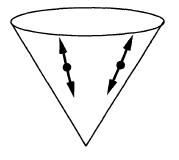
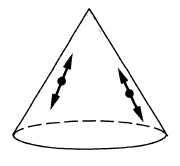 | | Peierls-Poisson bracket |
| advanced propagator | |  | | future part of
Peierls-Poisson bracket |
| retarded propagator | |  | | past part of
Peierls-Poisson bracket |
| Wightman propagator | |  | | positive frequency of
Peierls-Poisson bracket,
Wick algebra-product,
2-point function
of vacuum state
or generally of
Hadamard state |
| Feynman propagator | | 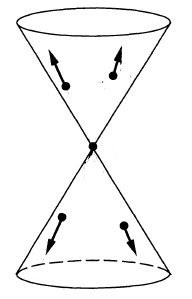 | | time-ordered product |
(see also Kocic‘s overview: pdf)
Examples
For Klein-Gordon operator on Minkowski spacetime
On Minkowski spacetime consider the Klein-Gordon operator
Its Fourier transform is
The dispersion relation of this equation we write
(1)
where on the right we choose the non-negative square root.
We now discuss
-
Advanced and retarded propagators
-
Causal propagator
-
Wightman propagator
-
Feynman propagator
-
Wave front sets
advanced and retarded propagators for Klein-Gordon equation on Minkowski spacetime
Proposition
(mode expansion of advanced and retarded propagators for Klein-Gordon operator on Minkowski spacetime)
The advanced and retarded Green functions of the Klein-Gordon operator on Minkowski spacetime are given by integral kernels (“propagators”)
by (in generalized function-notation)
where the advanced and retarded propagators have the following equivalent expressions:
Here denotes the dispersion relation (1) of the Klein-Gordon equation.
Proof
The Klein-Gordon operator is a Green hyperbolic differential operator (this example) therefore its advanced and retarded Green functions exist uniquely (this prop.). Moreover, this prop. says that they are continuous linear functionals with respect to the topological vector space structures on spaces of smooth sections (this def.). In the case of the Klein-Gordon operator this just means that
are continuous linear functionals in the standard sense of distributions. Therefore the Schwartz kernel theorem implies the existence of integral kernels being distributions in two variables
such that, in the notation of generalized functions,
These integral kernels are the advanced/retarded “propagators”. We now compute these integral kernels by making an Ansatz and showing that it has the defining properties, which identifies them by the uniqueness statement of this prop..
We make use of the fact that the Klein-Gordon equation is invariant under the defnining action of the Poincaré group on Minkowski spacetime, which is a semidirect product group of the translation group and the Lorentz group.
Since the Klein-Gordon operator is invariant, in particular, under translations in it is clear that the propagators, as a distribution in two variables, depend only on the difference of its two arguments
Since moreover the Klein-Gordon operator is formally self-adjoint (this prop.) this implies that for the Klein the equation (?)
is equivalent to the equation (?)
Therefore it is sufficient to solve for the first of these two equation, subject to the defining support conditions. In terms of the propagator integral kernels this means that we have to solve the distributional equation
(3)
subject to the condition that the distributional support is
We make the Ansatz that we assume that , as a distribution in a single variable , is a tempered distribution
hence amenable to Fourier transform of distributions. If we do find a solution this way, it is guaranteed to be the unique solution by this prop..
By this prop. the distributional Fourier transform of equation (3) is
(4)
where in the second line we used the Fourier transform of the delta distribution from this example.
Notice that this implies that the Fourier transform of the causal propagator
satisfies the homogeneous equation:
(5)
Hence we are now reduced to finding solutions to (4) such that their Fourier inverse has the required support properties.
We discuss this by a variant of the Cauchy principal value:
Suppose the following limit of non-singular distributions in the variable exists in the space of distributions
meaning that for each bump function the limit in
exists. Then this limit is clearly a solution to the distributional equation (4) because on those bump functions which happen to be products with we clearly have
Moreover, if the limiting distribution (6) exists, then it is clearly a tempered distribution, hence we may apply Fourier inversion to obtain Green functions
To see that this is the correct answer, we need to check the defining support property.
Finally, by the Fourier inversion theorem, to show that the limit (6) indeed exists it is sufficient to show that the limit in (7) exists.
We compute as follows
(8)
where denotes the dispersion relation (1) of the Klein-Gordon equation. The last step is simply the application of Euler's formula .
Here the key step is the application of Cauchy's integral formula in the fourth step. We spell this out now for , the discussion for is the same, just with the appropriate signs reversed.
- If thn the expression decays with positive imaginary part of , so that we may expand the integration domain into the upper half plane as
Conversely, if then we may analogously expand into the lower half plane.
- This integration domain may then further be completed to two contour integrations. For the expansion into the upper half plane these encircle counter-clockwise the poles at , while for expansion into the lower half plane no poles are being encircled.
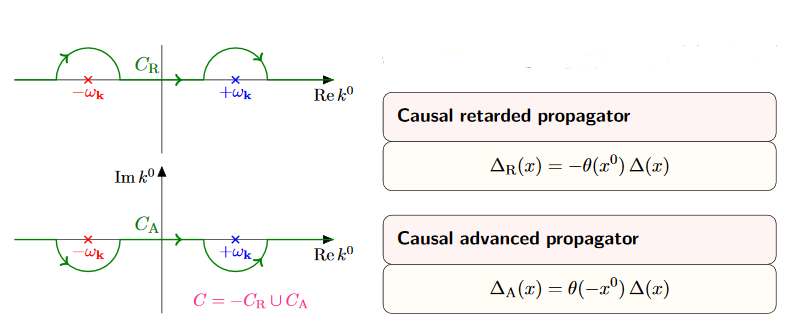
-
Apply Cauchy's integral formula to find in the case the sum of the residues at these two poles times , zero in the other case. (For the retarded propagator we get times the residues, because now the contours encircling non-trivial poles go clockwise).
-
The result is now non-singular at and therefore the limit is now computed by evaluating at .
This computation shows a) that the limiting distribution indeed exists, and b) that the support of is in the future, and that of is in the past.
Hence it only remains to see now that the support of is inside the causal cone. But this follows from the previous argument, by using that the Klein-Gordon equation is invariant under Lorentz transformations: This implies that the support is in fact in the future of every spacelike slice through the origin in , hence in the closed future cone of the origin.
Corollary
(causal propagator is skew-symmetric)
Under reversal of arguments the advanced and retarded causal propagators are related by
(9)
It follows that the causal propagator is skew-symmetric in its arguments:
Proof
By prop. we have with (2)
Here in the second step we applied change of integration variables (which introduces no sign because in addition to the integration domain reverses orientation).
causal propagator
Proposition
(mode expansion of causal propagator for Klein-Gordon equation on Minkowski spacetime)
The causal propagator (?) for the Klein-Gordon equation for mass on Minkowski spacetime is given, in generalized function notation, by
(10)
where in the second line we used Euler's formula .
In particular this shows that the causal propagator is real, in that it is equal to its complex conjugate
(11)
Proof
By definition and using the expression from prop. for the advanced and retarded causal propagators we have
For the reality, notice from the last line that
where in the last step we used the change of integration variables (whih introduces no sign, since on top of the orientation of the integration domain changes).
We consider a couple of equivalent expressions for the causal propagator:

graphics grabbed from Kocic 16
Proof
By Cauchy's integral formula we compute as follows:
The last line is the expression for the causal propagator from prop.
Proof
By decomposing the integral over into its negative and its positive half, and applying the change of integration variables we get
The last line is the expression for the causal propagator from prop. .
(e.g. Scharf 95 (2.3.18))
Proof
Consider the formula for the causal propagator in terms of the mode expansion (10). Since the integrand here depends on the wave vector only via its norm and the angle it makes with the given spacetime vector via
we may express the integration in terms of polar coordinates as follws:
We specialize further computation now to the case that the spacetime dimension is , in which case the above becomes
where in the last step we used one of the trigonometric identities.
In order to further evaluate this, we parameterize the remaining components of the wave vector by the dual rapidity , via
as
which makes use of the fact that is non-negative, by construction. This change of integration variables makes the integrals under the braces above become
Next we similarly parameterize the vector by its rapidity . That parameterization depends on whether is spacelike or not, and if not, whether it is future or past directed.
First, if is spacelike in that then we may parameterize as
which yields
where in the last line we observe that the integrand is a skew-symmetric function of .
Second, if is timelike with then we may parameterize as
which yields
Here denotes the Bessel function of order 0. The important point here is that this is a smooth function.
Similarly, if is timelike with then the same argument yields
In conclusion, the general form of is
Therefore we end up with
Wightman propagator
Prop. exhibits the causal propagator of the Klein-Gordon operator on Minkowski spacetime as the difference of a contribution for positive temporal angular frequency (hence positive energy and a contribution of negative temporal angular frequency.
The positive frequency contribution to the causal propagator is called the Wightman propagator (def. below), also known as the the vacuum state 2-point function of the free real scalar field on Minkowski spacetime. Notice that the temporal component of the wave vector is proportional to the negative angular frequency
(see at plane wave), therefore the appearance of the step function in (12) below:
Definition
(Wightman propagator or vacuum state 2-point function for Klein-Gordon operator on Minkowski spacetime)
The Wightman propagator for the Klein-Gordon operator at mass on Minkowski spacetime is the tempered distribution in two variables which as a generalized function is given by the expression
(12)
Here in the first line we have in the integrand the delta distribution of the Fourier transform of the Klein-Gordon operator times a plane wave and times the step function of the temporal component of the wave vector. In the second line we used the change of integration variables , then the definition of the delta distribution and the fact that is by definition the non-negative solution to the Klein-Gordon dispersion relation.
(e.g. Khavine-Moretti 14, equation (38) and section 3.4)
Proposition
(contour integral representation of the Wightman propagator for the Klein-Gordon operator on Minkowski spacetime)
The Wightman propagator from def. is equivalently given by the contour integral
(13)
where the Jordan curve runs counter-clockwise, enclosing the point , but not enclosing the point .

graphics grabbed from Kocic 16
Proof
We compute as follows:
The last step is application of Cauchy's integral formula, which says that the contour integral picks up the residue of the pole of the integrand at . The last line is , by definition .
Proposition
(skew-symmetric part of Wightman propagator is the causal propagator)
The Wightman propagator for the Klein-Gordon equation on Minkowski spacetime (def. ) is of the form
(14)
where
-
is the causal propagator (prop. ), which is real (11) and skew-symmetric (prop. )
-
is real and symmetric
(15)
Proof
By applying Euler's formula to (12) we obtain
(16)
On the left this identifies the causal propagator by (10), prop. .
The second summand changes, both under complex conjugation as well as under , via change of integration variables (because the cosine is an even function). This does not change the integral, and hence is symmetric.
Feynman propagator
We have seen that the positive frequency component of the causal propagator for the Klein-Gordon equation on Minkowski spacetime (prop. ) is the Wightman propagator (def. ) given, according to prop. , by (14)
There is an evident variant of this combination, which will be of interest:
It follows immediately that:
Proof
By equation (9) in cor. we have that is symmetric, and (15) in prop. says that is symmetric.
Proposition
(mode expansion for Feynman propagator of Klein-Gordon equation on Minkowski spacetime)
The Feynman propagator (def. ) for the Klein-Gordon equation on Minkowski spacetime is given by the following equivalent expressions
Similarly the anti-Feynman propagator is equivalently given by
Proof
By the mode expansion of from (2) and the mode expansion of from (16) we have
where in the second line we used Euler's formula. The last line follows by comparison with (12) and using that the integral over is invariant under .
The computation for is the same, only now with a minus sign in front of the cosine:
As before for the causal propagator, there are equivalent reformulations of the Feynman propagator, which are useful for computations:
Proof
We compute as follows:
Here
-
In the first step we introduced the complex square root . For this to be compatible with the choice of non-negative square root for in (1) we need to choose that complex square root whose complex phase is one half that of (instead of that plus π). This means that is in the upper half plane and is in the lower half plane.
-
In the third step we observe that
-
for the integrand decays for positive imaginary part and hence the integration over may be deformed to a contour which encircles the pole in the upper half plane;
-
for the integrand decays for negative imaginary part and hence the integration over may be deformed to a contour which encircles the pole in the lower half plane
and then apply Cauchy's integral formula which picks out times the residue a these poles.
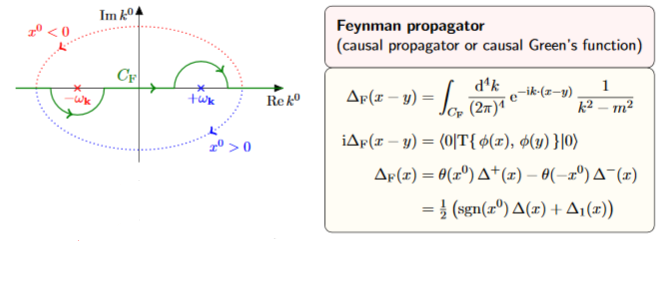
Notice that when completing to a contour in the lower half plane we pick up a minus signs from the fact that now the contour runs clockwise.
-
In the fourth step we used prop. .
singular support and wave front sets
We now discuss the singular support and the wave front sets of the various propagators for the Klein-Gordon equation on Minkowski spacetime.
Proof
The statement follows immediately from the result (Gel’fand-Shilov 66, III 2.10 (7), p 294), see this prop.
We make this fully explicit now in the special case of spacetime dimension
by computing an explicit form for the causal propagator in terms of the delta distribution, the Heaviside distribution and smooth Bessel functions.
We follow (Scharf 95 (2.3.18)).
Consider the formula for the causal propagator in terms of the mode expansion (10). Since the integrand here depends on the wave vector only via its norm and the angle it makes with the given spacetime vector via
we may express the integration in terms of polar coordinates as follws:
In the special case of spacetime dimension this becomes
(17)
Here in the second but last step we renamed and doubled the integration domain for convenience, and in the last step we used the trigonometric identity .
In order to further evaluate this, we parameterize the remaining components of the wave vector by the dual rapidity , via
as
which makes use of the fact that is non-negative, by construction. This change of integration variables makes the integrals under the braces above become
(18)
Next we similarly parameterize the vector by its rapidity . That parameterization depends on whether is spacelike or not, and if not, whether it is future or past directed.
First, if is spacelike in that then we may parameterize as
which yields
where in the last line we observe that the integrand is a skew-symmetric function of .
Second, if is timelike with then we may parameterize as
which yields
(19)
Here in the last line we identified the integral representation of the Bessel function of order 0 (see here). The important point here is that this is a smooth function.
Similarly, if is timelike with then the same argument yields
In conclusion, the general form of is
Therefore we end up with
(20)
Proof
The statement follows immediately from the result (Gel’fand-Shilov 66, III 2.10 (7), p 294), see this prop..
We make this fully explicit now in the special case of spacetime dimension
by computing an explicit form for the causal propagator in terms of the delta distribution, the Heaviside distribution and smooth Bessel functions.
We follow (Scharf 95 (2.3.36)).
By (16) we have
The first summand, proportional to the causal propagator, which we computed as (20) in prop. to be
The second term is computed in a directly analogous fashion: The integrals from (18) are now
Parameterizing by rapidity, as in the proof of prop. , one finds that for timelike this is
while for spacelike it is
where we identified the integral representations of the Neumann function (see here) and of the modified Bessel function (see here).
As for the Bessel function in (19) the key point is that these are smooth functions. Hence we conclude that
This expression has singularities on the light cone due to the step functions. In fact the expression being differentiated is continuous at the light cone (Scharf 95 (2.3.34)), so that the singularity on the light cone is not a delta distribution singularity from the derivative of the step functions. Accordingly it does not cancel the singularity of as above, and hence the singular support of is still the whole light cone.
Proposition
(wave front sets of propagators of Klein-Gordon equation on Minkowski spacetime)
The wave front set of the various propagators for the Klein-Gordon equation on Minkowski spacetime, regarded, via translation invariance, as distributions in a single variable, are as follows:
- the causal propagator (prop. ) has wave front set all pairs with and both on the lightcone:

-

- the Wightman propagator (def. ) has wave front set all pairs with and both on the light cone and :

- the Feynman propagator (def. ) has wave front set all pairs with and both on the light cone and

(Radzikowski 96, (16))
Proof
First regarding the causal propagator:
By prop. the singular support of is the light cone.
Since the causal propagator is a solution to the homogeneous Klein-Gordon equation, the propagation of singularities theorem says that also all wave vectors in the wave front set are lightlike. Hence it just remains to show that all non-vanishing lightlike wave vectors based on the lightcone in spacetime indeed do appear in the wave front set.
To that end, let be a bump function whose compact support includes the origin.
For a point on the light cone, we need to determine the decay property of the Fourier transform of . This is the convolution of distributions of with . By prop. we have
This means that the convolution product is the smearing of the mass shell by .
Since the mass shell asymptotes to the light cone, and since for on the light cone (given that is on the light cone), this implies the claim.
Now for the Wightman propagator:
By def. its Fourier transform is of the form
Moreover, its singular support is also the light cone (prop. ).
Therefore now same argument as before says that the wave front set consists of wave vectors on the light cone, but now due to the step function factor it must satisfy .
Finally regarding the Feynman propagator:
by prop. the Feynman propagator coincides with the positive frequency Wightman propagator for and with the “negative frequency Hadamard operator” for . Therefore the form of now follows directly with that of above.
For Dirac operator on Minkowski spacetime
Finally we observe that the propagators for the Dirac field on Minkowski spacetime follow immediately from the propagators for the scalar field:
Proposition
(advanced and retarded propagator for Dirac equation on Minkowski spacetime)
Consider the Dirac operator on Minkowski spacetime, which in Feynman slash notation reads
Its advanced and retarded propagators (def. ) are the derivatives of distributions of the advanced and retarded propagators for the Klein-Gordon equation (prop. ) by :
Hence the same is true for the causal propagator:
Proof
Applying a differential operator does not change the support of a smooth function, hence also not the support of a distribution. Therefore the uniqueness of the advanced and retarded propagators (prop. ) together with the translation-invariance and the anti-formally self-adjointness of the Dirac operator (as for the Klein-Gordon operator (?) implies that it is sufficent to check that applying the Dirac operator to the yields the delta distribution. This follows since the Dirac operator squares to the Klein-Gordon operator:
Similarly we obtain the other propagators for the Dirac field from those of the real scalar field:
Definition
(Wightman propagator for Dirac operator on Minkowski spacetime)
The Wightman propagator for the Dirac operator on Minkowski spacetime is the positive frequency part of the causal propagator (prop. ), hence the derivative of distributions of the Wightman propagator for the Klein-Gordon field (def. ) by the Dirac operator:
Here we used the expression (?) for the Wightman propagator of the Klein-Gordon equation.
Definition
(Feynman propagator for Dirac operator on Minkowski spacetime)
The Feynman propagator for the Dirac operator on Minkowski spacetime (also called the electron propagator) is the linear combination
of the Wightman propagator (def. ) and the retarded propagator (prop. ). By prop. this means that it is the derivative of distributions of the Feynman propagator of the Klein-Gordon equation (def. ) by the Dirac operator
In Feynman amplitudes
Example
(Feynman amplitudes in causal perturbation theory – example of QED)
In perturbative quantum field theory, Feynman diagrams are labeled multigraphs that encode products of Feynman propagators, called Feynman amplitudes (this prop.) which in turn contribute to probability amplitudes for physical scattering processes – scattering amplitudes:
The Feynman amplitudes are the summands in the Feynman perturbation series-expansion of the scattering matrix
of a given interaction Lagrangian density .
The Feynman amplitudes are the summands in an expansion of the time-ordered products of the interaction with itself, which, away from coincident vertices, is given by the star product of the Feynman propagator (this prop.), via the exponential contraction
Each edge in a Feynman diagram corresponds to a factor of a Feynman propagator in , being a distribution of two variables; and each vertex corresponds to a factor of the interaction Lagrangian density at .
For example quantum electrodynamics in Gaussian-averaged Lorenz gauge involves (via this example):
-
the Dirac field modelling the electron, with Feynman propagator called the electron propagator (this def.), here to be denoted
-
the electromagnetic field modelling the photon, with Feynman propagator called the photon propagator (this prop.), here to be denoted
-
the electron-photon interaction
The Feynman diagram for the electron-photon interaction alone is
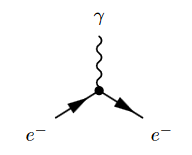
where the solid lines correspond to the electron, and the wiggly line to the photon. The corresponding product of distributions is (written in generalized function-notation)
Hence a typical Feynman diagram in the QED Feynman perturbation series induced by this electron-photon interaction looks as follows:
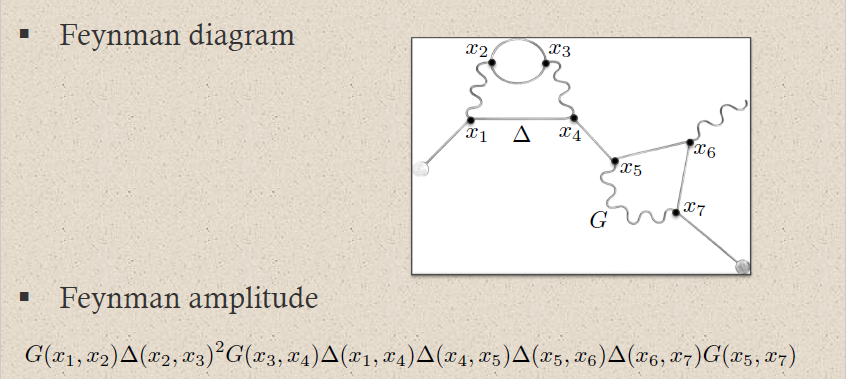
where on the bottom the corresponding Feynman amplitude product of distributions is shown; now notationally suppressing the contraction of the internal indices and all prefactors.
For instance the two solid edges between the vertices and correspond to the two factors of :

This way each sub-graph encodes its corresponding subset of factors in the Feynman amplitude:


graphics grabbed from Brouder 10
A priori this product of distributions is defined away from coincident vertices: . The definition at coincident vertices requires a choice of extension of distributions to the diagonal locus. This choice is the ("re-")normalization of the Feynman amplitude.
As a zeta function
needs harmonization
From another perspective, the loop contributions of Feynman diagrams are typically would-be traces over inverse powers of the relativistic particle Hamiltonian.
For instance for the free scalar particle of mass in 4d Minkowski spacetime the 1-loop vacuum amplitude is the regularized trace over the Feynman propagator
where the integral would naively be over all of , which is of course not well defined. The integrand here is typically called the Feynman propagator or propagator for short (e.g. Grozin 05, section 2.1 Kleinert 11, 8.1). See at Feynman diagram – For finitely many degrees of freedoms for how this comes about.
Several methods are considered for regularizing, hence making sense of it as a finite expression. One of these is zeta function regularization (also “analytic regularization/renormalization” Speer 71). Here one notices that the zeta function of the wave operator/Laplace operator is well-defined for by the naive trace
and defined from there by analytic continuation on allmost all of the complex plane. The special value at (or its principal value) is the regularized Feynman propagator. See (BCEMZ 03, section 2.4.2). For the example of the above basic Feynman propagator see e.g. Grozin 05, section 2.1
Representing the (completed) zeta function here are the Mellin transform of some theta function – which in the present case is the partition function of the worldline formalism of the given theory, is what in the physics literature is known as the Schwinger parameter-formulation
| context/function field analogy | theta function | zeta function (= Mellin transform of ) | L-function (= Mellin transform of ) | eta function | special values of L-functions |
|---|
| physics/2d CFT | partition function as function of complex structure of worldsheet (hence polarization of phase space) and background gauge field/source | analytically continued trace of Feynman propagator | analytically continued trace of Feynman propagator in background gauge field : | analytically continued trace of Dirac propagator in background gauge field | regularized 1-loop vacuum amplitude / regularized fermionic 1-loop vacuum amplitude / vacuum energy |
| Riemannian geometry (analysis) | | zeta function of an elliptic differential operator | zeta function of an elliptic differential operator | eta function of a self-adjoint operator | functional determinant, analytic torsion |
| complex analytic geometry | section of line bundle over Jacobian variety in terms of covering coordinates on | zeta function of a Riemann surface | Selberg zeta function | | Dedekind eta function |
| arithmetic geometry for a function field | | Goss zeta function (for arithmetic curves) and Weil zeta function (in higher dimensional arithmetic geometry) | | | |
| arithmetic geometry for a number field | Hecke theta function, automorphic form | Dedekind zeta function (being the Artin L-function for the trivial Galois representation) | Artin L-function of a Galois representation , expressible “in coordinates” (by Artin reciprocity) as a finite-order Hecke L-function (for 1-dimensional representations) and generally (via Langlands correspondence) by an automorphic L-function (for higher dimensional reps) | | class number regulator |
| arithmetic geometry for | Jacobi theta function ()/ Dirichlet theta function ( a Dirichlet character) | Riemann zeta function (being the Dirichlet L-function for Dirichlet character ) | Artin L-function of a Galois representation , expressible “in coordinates” (via Artin reciprocity) as a Dirichlet L-function (for 1-dimensional Galois representations) and generally (via Langlands correspondence) as an automorphic L-function | | |
References
Analytical aspects of special generalized functions associated to quadratic forms are given in
Textbook accounts for quantum fields on Minkowski spacetime includes
An concise overview of the Green functions of the Klein-Gordon operator, hence of the Feynman propagator, advanced propagator, retarded propagator, causal propagator etc. is given in
- Mikica Kocic, Invariant Commutation and Propagation Functions Invariant Commutation and Propagation Functions, 2016 (pdf)
Discussion on general globally hyperbolic spacetimes is in
- Marek Radzikowski, Micro-local approach to the Hadamard condition in quantum field theory on curved space-time, Commun. Math. Phys. 179 (1996), 529–553 (Euclid)
where the issue with the underlying Wightman propagators was settled, and reviewed for instance in
- A. Bytsenko, G. Cognola, Emilio Elizalde, Valter Moretti, S. Zerbini, section 2 of Analytic Aspects of Quantum Fields, World Scientific Publishing, 2003, ISBN 981-238-364-6
Lecture notes (mostly for the case over Minkowski spacetime) include
-
Andrey Grozin, Lectures on QED and QCD (arXiv:hep-ph/0508242)
-
Green functions and propagators (pdf)
-
Green functions for the Klein-Gordon operator (pdf)
-
Hagen Kleinert, V. Schulte-Frohlinde, Critical properties of -Theories 2001 (pdf)
An overview of the Green functions of the Klein-Gordon operator, hence of the Feynman propagator, advanced propagator, retarded propagator, causal propagator etc. is given in
- Mikica Kocic, Invariant Commutation and Propagation Functions Invariant Commutation and Propagation Functions, 2016 (pdf)
The zeta function regularization method originates around
- Eugene Speer, On the structure of Analytic Renormalization, Comm. math. Phys. 23, 23-36 (1971) (Euclid)
and a comprehensive discussion is in (BCEMZ 03, section 2).
Discussion of zeta functions of Dirac operators in 2d includes
- Michael McGuigan, Riemann Hypothesis and Short Distance Fermionic Green’s Functions (arXiv:math-ph/0504035)
Lecture notes concerning 1-loop vacuum amplitudes for the string include
- The IIA/B superstring one-loop vacuum amplitude (pdf)












